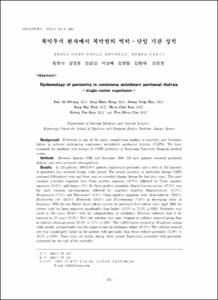복막투석 환자에서 복막염의 역학 - 단일 기관 성적
- Keimyung Author(s)
- Kim, Hyoung Tae; Cho, Won Hyun; Hwang, Eun Ah; Han, Seung Yeup; Park, Sung Bae; Kim, Hyun Chul
- Journal Title
- 대한내과학회지
- Issued Date
- 2002
- Volume
- 63
- Issue
- 3
- Abstract
- Background : Peritonitis is one of the major complication leading to mortality and technique
failure in patients undergoing continuous ambulatory peritoneal dialysis (CAPD). We have
examined the incidence and etiology of CAPD peritonitis at Keimyung University Dongsan medical
center.
Methods : Between January 1996 and December 2000, 238 new patients received peritoneal
dialysis and were reviewed retrospectively.
Results : In 238 patients, 109(45.8%) patients experienced peritonitis and a total of 192 episodes
of peritonitis has occurred during study period. The overall incidence of peritonitis during CAPD
averaged 0.94/patient-year and there was no essential change during the last five years. The most
common causative organism was Gram positive organism (41.7%), followed by Gram negative
organism (14.1%), and fungus (2%). In Gram positive organism, Staphylococcus aureus (47.5%) was
the most common microorganism, followed by coagulase negative Staphylococcus (23.5%),
Streptococci (7.5%), and Enterococci (5.5%). Gram negative organism were Acinetobactor (29.6%),
Escherichia coli (18.5%), Klebsiella (18.5%) and Pseudomonas (7.4%) in decreasing order of
frequency. With the use Bactec blood culture system for peritoneal fluid culture since April 2000, the
culture yield has been improved significantly than before (52.5% vs 72.2%, p<0.05). Peritonitis was
cured in 164 cases (85.6%) with the administration of antibiotics. However catheters had to be
removed in 23 cases (11.8%). Exit-site infection was more frequent in catheter removal group than
in catheter retaining group (17.4% vs 4.7%, p<0.05). The CAPD failure occured in 28 patients during
study period, and peritonitis was the major reason for technique failure (82.1%). The catheter removal
rate was significantly higher in the patients with peritonitis than those without peritonitis (55.0% vs
30.2%, p<0.05). There were six deaths during study period. Septicemia associated with peritonitis
accounted for the half of the mortality.
목적 : 복막투석 환자에서 복막염은 복막투석의 실패
와 사망에 가장 중요한 합병증의 하나이다. 저자들은 계
명대학교 동산의료원에서 복막투석을 시행한 환자들을
대상으로 하여 복막염의 발생 및 역학에 대해 조사하였
다.
방법 : 1996년 1월에서 2000년 12월 사이에 계명대학
교 동산의료원에서 복막투석을 시행받은 환자들 중 추
적기간이 2개월 이상인 238명을 대상으로 하여 후향적
으로 조사하였다.
결과 : 5년간의 복막염의 발생율은 평균 0.94회/환자-
년(12.8개월당 1회)이었고, 복막염 원인균의 빈도는 그람
양성균이 41.7%, 그람 음성균이 14.1%, 진균이 1% 순이
었으며 배양 음성인 경우가 42.7%였다. 그람 양성균 중
에는 Staphylococcus aureus가 47.5%로 가장 많았고, 그
람 음성균에서는 Acinetobacter가 29.6%를 차지하였다.
균배양 양성율은 Bactec 혈액 배양 방식의 도입 이전
52.5%, 도입 후 72.2%로 균배양 양성율이 유의하게 향
상되었다. 복막염은 항생제의 사용으로 치료된 예는
85.6%였고, 11.8%에서는 도관이 제거가 필요하였다. 도
관을 제거하였던 경우 출구 감염이 도관을 제거하지 않았던 군보다 유의하게 많았다(17.4% vs 4.7%). 전체 109
명의 환자 중 60예에서 복막투석을 중단하였고, 그 중
28예가 혈액투석으로 전환하였으며 그 원인으로는 복막
염이 82.1%로 가장 많았다. 도관 생존율은 복막염을 경
험한 환자군에서는 1년, 3년, 5년 도관 생존율이 각각
87.0%, 35.1%, 11.9%였으며 복막염을 경험한 환자군에
서는 1년, 3년, 5년 도관 생존율이 각각 81.7%, 58.1%,
54.0%였다. 관찰 기간 동안 6예가 사망하였으며 그 중
절반이 복막염에 의한 패혈증으로 사망하였다.
결론 : 앞으로 복막염의 발생을 감소시키기 위해서는
투석액 교환시 감염 및 도관 주위감염에 대한 적극적인
치료와 주기적인 환자 교육이 필요할 것으로 생각된다.
- Alternative Title
- Epidemiology of peritonitis in continuous ambulatory peritoneal dialysis - single center experience -
- Publisher
- School of Medicine
- Citation
- 황은아 et al. (2002). 복막투석 환자에서 복막염의 역학 - 단일 기관 성적. 대한내과학회지, 63(3), 314–321.
- Type
- Article
- ISSN
- 1226-329x
- 파일 목록
-
-
Download
 oak-bbb-00711.pdf
기타 데이터 / 332.9 kB / Adobe PDF
oak-bbb-00711.pdf
기타 데이터 / 332.9 kB / Adobe PDF
-
Items in Repository are protected by copyright, with all rights reserved, unless otherwise indicated.